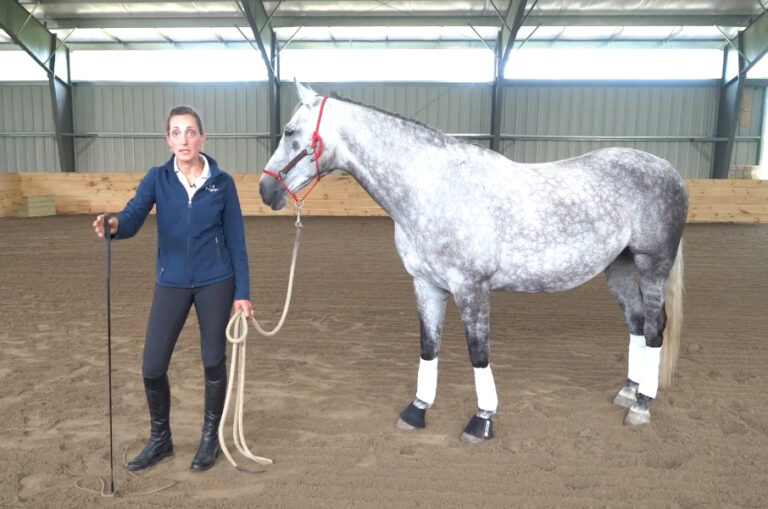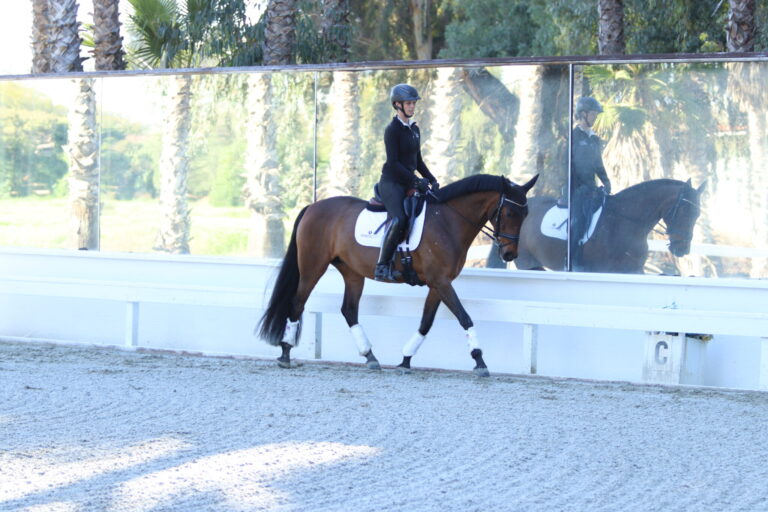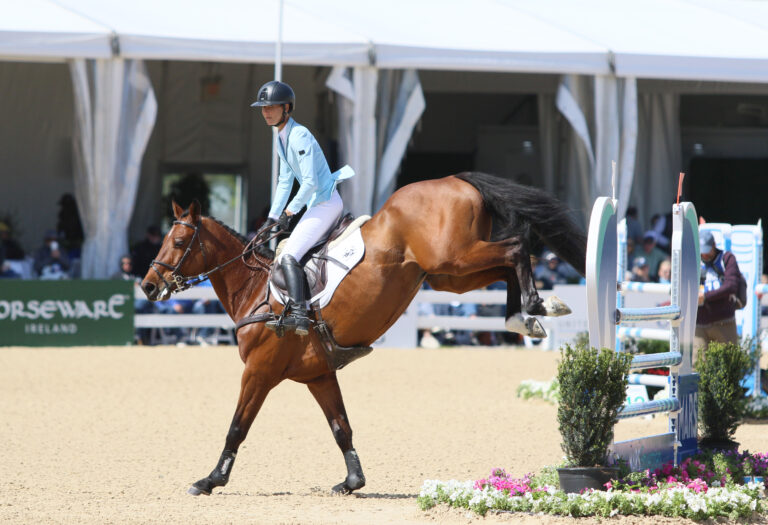Eventing is a dangerous sport. The hard truth is that as long as 100-pound humans meet up with 1,000-pound horses, humans (and sometimes horses) are going to get hurt.

© HORSESTOCK.BIZ
Both the U.S. Equestrian Federation (USEF) and Federation Equestre Internationale (FEI) are actively engaged in making our sport as safe as possible. Even as we welcome their efforts, however, we should view with a little suspicion any effort to do something for people that they can do better by themselves.
Several reasons have been suggested for eventing fatalities including loss of balance at speed, fence design…and just plain bad luck. The one factor I think has the greatest effect on safety, however, is the competence of the horse and rider. (This also goes back to the “bad luck” factor: Although the capricious nature of luck is one of the hardest things to deal with as you go through your life, it is also a widely quoted aphorism in sport that the harder athletes work, the luckier they get.)
We can improve fence design, and we can draw up increasingly complicated qualification schemes to control when a rider is allowed to move up to the next level of eventing. However, we cannot help riders who confuse being qualified to compete at a given level with being ready to compete there.
Not a Simple Fix
Eventing is a terribly complicated sport, and it is hard to examine one facet of the sport without considering all the others as well. For example, in the late 1990s and early 2000s, a horrible number of rider fatalities suddenly occurred. In response to these fatalities, course designers were instructed to build cross-country courses that contained more complex combinations and accuracy questions. The thinking was that this new design would serve to slow the competitors down, which would make the sport safer. It was a good idea, but it did not work.
What happened next is that riders figured out how to jump the accuracy questions at slow rates of speed and then to gallop at a terrific pace to make up for the time lost in the slower sections of the course. While it has become common for riders to “make the time” at most events (when was the last time you watched Rolex and nobody made the cross-country time?), they are now going at speeds that once were reserved for the steeplechase phase of the Classic format, where riders jump at high rates of speed over soft brush fences. Because of the change to the short format, we are now seeing a generation of riders and horses who have never done a steeplechase phase. This means that when riders move to the next level of competition, for which they are “qualified,” many of them are going at a higher rate of speed for the first time.
Obviously, the riders are inexperienced at this new speed, and they are going to arrive at an obstacle out of rhythm, or “miss.” Just as obviously, the penalties for missing at a solid obstacle are much more dangerous than coming too close to a soft brush fence with a sloping outline. You might notice that I have not said much about horses as being part of the problem, because it is not the horses who are the problem, it is the riders. Horses don’t like to fall down and if riders can learn to stay out of their horses’ way, both horse and rider will usually have a safe and enjoyable time of it. Certainly you need the right horse for the job, and I can give you some help in finding a suitable horse for eventing. Reread my May 2006 column in Practical Horseman on selecting the right horse for eventing. Just remember that once you have taught your horse how to do something, your job is to tell him what to do, and then stay out of his way.
The ramifications of building more complex cross-country courses are that we now have courses that are basically a series of complicated show-jumping questions, which demand a slow, balanced approach. These combinations are usually followed by several plain obstacles designed to be jumped at speed. This sort of design causes more and more extreme changes in the length of stride of the horses, with more and more chances for riders to lose their rhythm and balance. The reason for this is that the slower you make riders go to negotiate the combinations, the faster they have to go elsewhere on course, to achieve the required optimum time.
Requirement: Good Balance
The term “rotational fall” has entered our lexicon because of the type of fatalities that have occurred. A rotational fall happens when the horse and rider both fall in a straight line, with no sideways momentum at all. One knee-jerk response to tragedies is to say “rotational falls are highly dangerous, and they always happen over plain fences at high speed.” This is not true. I can remember when people were saying that “rotational falls are caused by horses jumping from a standstill.” The grim truth is that rotational falls can happen at any speed and are always dangerous for both horses and riders.
Another statement has been that horses are jumping badly because riders are not “setting up” (i.e. checking) for their fences correctly, and therefore riders have to learn to check more. This makes superficial sense, until you watch horses race over fences at the Maryland Hunt Cup, or journey to Aintree, England, to watch the English Grand National. Have you ever watched either of these races? The fences at the Maryland Hunt Cup vary from 4 feet to 4-foot-10 in height (that is not a misprint. 4 feet, 10 inches) and the average speed for this 4-mile race is about 800 meters per minute (mpm). The fences at the English Grand National range up to 5-foot-3; again, the average rate of speed over this 4-mile steeplechase is about 800 mpm. My point in bringing this up is that it is wrong to equate speed with bad jumping. Bad jumping can happen at any speed. I have watched some of the most brilliant, stylish jumping I have ever seen at the Hunt Cup. At the same time, I have watched novice eventing riders skidding around like a hog on ice at 350 mpm. The thing I want you to remember is that speed and balance are not mutually exclusive.
In my younger and braver days I did some steeplechasing and timber racing. I was not very good at it, but I learned an enormous amount from my experiences there–and had a ball while I was doing it. One of the things I learned was that some horses could gallop on a soft hold down to fixed fences at what race-horse trainers call a “two-minute lick” (roughly 800 mpm) and jump like a bird. They were naturally well balanced, and they jumped well as a result of that balance. Other horses needed a great deal of support from my reins, and I soon found out that those were the dangerous ones! Any horse who is heavy in the reins (in whatever discipline and at whatever speed) is depending on you to maintain his balance. This makes any minor mistake at the base of the jump even more dangerous, because the horse is not in balance at the moment of takeoff.
I survived my experiences and learned from them, but it was luck, rather than skill, that saved the day. The overall lesson I learned was that horses who were in a good balance jumped well, regardless of the speed that we were going at any particular time.
Things started to improve and become safer for me once I started to apply my dressage training, with its emphasis on balance and self-carriage, to training my horses over fences. As I developed my competence, my risk factor became much lower.
Develop Your Competence
I think our safety statistics would show a marked improvement if riders would work more on their competence and less on their qualifications. At the same time, riders do not go out to ride dangerously on purpose…it happens by accident. For example, many riders consistently throw their body ahead of the horse as he takes off. It is now only a question of time before that horse and rider have an accident because the horse is out of balance as he tries to jump.
Many times, riders are not aware of how they ride. So I have developed a self-rating system to help them evaluate their current level of riding and to highlight the skills riders need to improve before they are “ready” to compete at the next level and not just “qualified.” Use my rating system to determine where you fit on a scale of 1 to 10, and compare your skill levels to the riders you see competing at the upper levels. Once you rate yourself, you will have a much better idea of the level at which you are ready to ride, rather than relying on a mechanical qualification system. In addition, you will have a much better idea of the areas you have to improve to increase your competence.
We need to take a long, hard look at our sport and see what we can change, and what we have to accept. USEF president and Olympic gold-medal winning eventer David O’Connor said, “You can’t make eventing safer than life itself.” If we increase rider competence, we will do the very best thing we can for our sport. We can’t make eventing safer than life itself, but we can make it as safe as possible. We just have to work at it. I hope you join me in the effort.
Rate Your Riding
This rating system (below) is designed to help you produce safe and effective riding. It should be applied with the help of an expert coach or horseman, if possible. The competitive levels are not specifically referred to in the table, but basically the upper levels of the rating system equate to the upper competitive levels. For example, Level 9 and 10 riders would be ready to compete at the 4-star level, Level 8 for 3-star, and so on down the scale. While no rating system can guarantee safety, a system such as this can at least make you aware of the areas of strength and weakness in your riding and give you a guideline as to when you are ready to compete at a higher level, rather than being merely qualified.
I recommend you satisfy the requirements for one level across the board before moving to the next level of competition. Because the risk factor is lower in the dressage phase, you might be able to compete safely at the next higher level if you have a horse who is a good jumper. However, the relationship between dressage and jumping is complex and pervasive, so your show-jumping and cross-country skills must be extremely solid before you undertake to compete above your dressage rating level. You should never compete more than one level above your dressage rating, and I strongly recommend that you be at the required skill level before competing at the equivalent competitive level. If you compete at a higher level but cannot yet satisfy the requirements of the skill level, then you are a menace to society and to yourself, regardless of any administrative “qualification.”
For example, if you still “chase” your horse to a long stride, you should not move up until you have learned how to ride correctly and safely at the new required height and speed.
Use your judgment when rating yourself, and when it comes to moving to the next competitive level, “use your head.”



This article originally appeared in the March 2008 issue of Practical Horseman.











